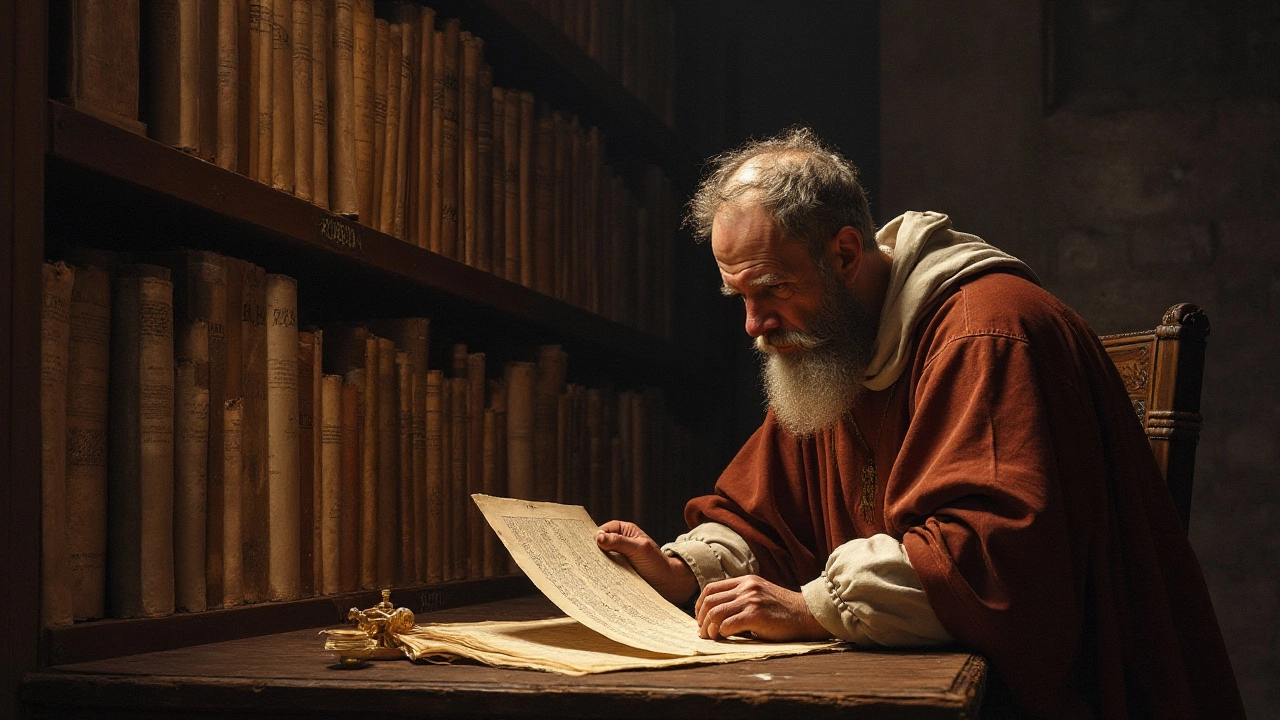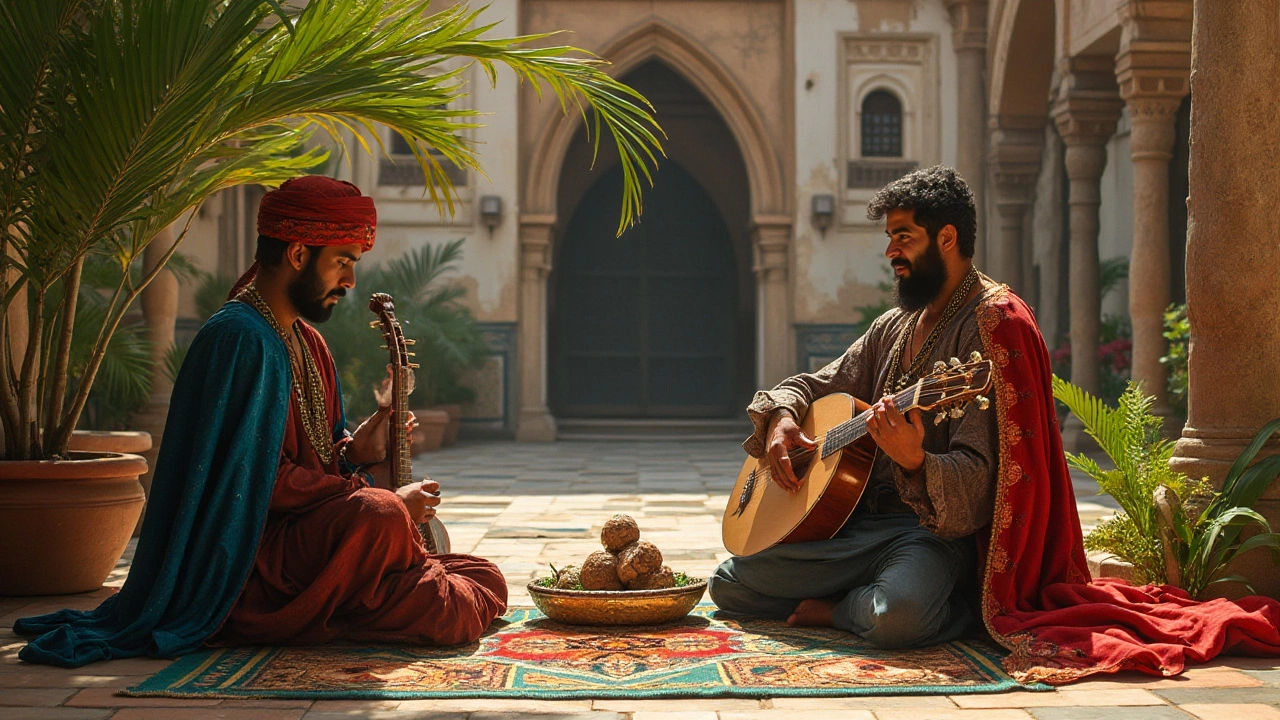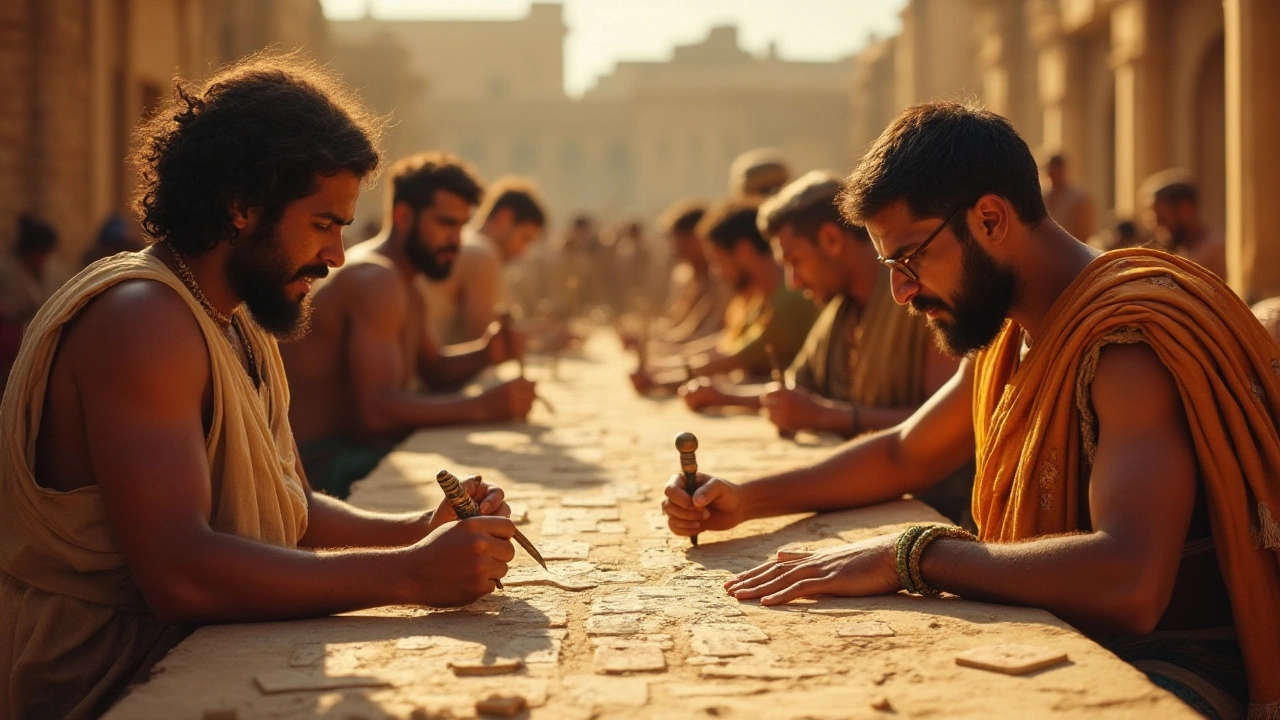Have you ever wondered where the music we cherish today first got its structure? Like many of the world's great inventions, written music has a story rooted deeply in human civilization. From the rhythm-filled rituals of ancient times to the intricate compositions of the Renaissance, the journey of music from oral tradition to written form is as fascinating as it is complex.
This narrative winds its way through various cultures and individuals who contributed to the preservation and evolution of music. As societies expanded, the need for a consistent musical language became vital. This need gave rise to notation systems that not only captured melodies but also transcended generations, allowing us to hear echoes from centuries ago.
We'll explore who these musical pioneers were, how they shaped what we now understand as music literacy, and the continued impact their innovations have on today's musical landscape. Ready to travel back in time and uncover the origins of music writing?
- The Ancient Beginnings
- The Greek Influence
- Medieval Developments
- Renaissance Composers
- The Baroque Era
- The Legacy of Music Writing
The Ancient Beginnings
Music has been an integral part of human life since the dawn of civilization itself. The journey to understanding this universal language begins with early societies, whose music was woven into the fabric of daily life. While the exact origins of written music remain somewhat elusive, artifacts and historical evidence provide tantalizing glimpses into these prehistoric symphonies. Our ancient forebears, though possessing no formal written system as we know it, laid the groundwork for what would eventually become musical notation. The need to preserve their cultural rituals and oral traditions across generations sowed the seeds for systematic music history documentation.
One of the earliest known musical compositions was discovered in the ruins of the ancient city of Ugarit, in modern-day Syria. This remarkable artifact, known as the Hurrian Hymn No. 6, dates back to 1400 BCE and provides evidence of an early attempt at musical transcription. Not written in staff form, it is instead a system of cuneiform script found on a clay tablet, translating melodies through a series of instructions.
"The development of cuneiform writing, which started as early as 3500 BCE, revolutionized record keeping and storytelling, thus impacting cultural expressions such as music," notes historian Karen Radner.The melody, despite its age, reveals the ingenuity of these ancient scribes and their capacity to encapsulate intangible art in tangible formats.
In the river valleys of Egypt, the soundscape of the ancient world was enriched by vibrant instruments like the lyre and lute. Egyptian musicians not only played these instruments during ceremonies but documented their chords and harmonies through pictorial representations. While not a traditional form of songwriting as we might recognize, these images signify an early understanding of music’s structure and its cultural importance. Hints of notation can even be found in the rhythmic representations carved into the walls of temple complexes, indicating that the Egyptians, much like their Mesopotamian neighbors, were in pursuit of recording musical history for posterity. This is reflected in their belief that music held the power to connect the earthly with the divine.
Charts and archaeological findings show that in the Indus Valley, percussive patterns and rhythmic cycles were essential to their sonic expressions. Though no written records remain, the legacy of the beats laid down by these ancient musicians is still felt today in traditional South Asian music forms, evidence of the enduring influence of these primal sounds. The absence of a formalized script should not be mistaken as a lack of sophistication; instead, it speaks to a different form of musical preservation reliant on community memory and oral repetition.
Every culture has its medium, from clay tablets in Babylonia to papyrus scrolls along the Nile. Looking at Indigenous Australian cultures, the use of symbolism on cave paintings and artifacts demonstrates their cultural immersion in music, even though it wasn’t always documented with pen and ink. This multifaceted approach to early music notation symbolizes the diversity of human culture and the variances in how societies understood and preserved their musical identities. As music became crucial for storytelling, teaching, and entertainment, the necessity for a more standardized written form grew, setting the stage for the Greek contributions that followed.
The Greek Influence
The ancient Greeks played a pivotal role in shaping the world of music as we know it today. They were among the first cultures to develop a theoretical framework for music, laying down foundations that would influence later European traditions. The Greeks saw music as a divine art form, intricately tied to mathematics and astronomy, revealing its cosmic harmony through sound. This concept was championed by philosophers like Pythagoras, who discovered that musical intervals could be expressed in numerical ratios, forever changing the way music was understood.
Greek music theory introduced basic concepts of scale and mode, which served as blueprints for later development in musical notation. The modes, known as the Dorian, Phrygian, Lydian, and Mixolydian, offered different tonalities and emotional expressions. For the Greeks, these modes were more than just sound patterns; they were deeply connected to character and mood. This understanding of music as an expression of ethos is evident in their myths and legends, where musicians and poets played critical roles in society. As a result, their festivals and theatrical performances heavily relied on music, embedded with complex polyphonic structures.
A fascinating aspect of Greek influence is their use of letters and symbols to denote pitch and duration, a precursor to modern notation. Although much of what they knew was taught orally, surviving documents like the 'Seikilos Epitaph' demonstrate their early attempts to record music. This artifact, inscribed on a tombstone, is the oldest known example of a complete musical composition with notation, displaying the Greeks' desire to preserve their rich musical heritage.
The philosopher Aristotle once stated, "Music has the power of producing a certain effect on the moral character of the soul, and if it has the power to do this, it is clear that the young must be directed to music and must be educated in it."His insight underscores the integral role of music in education and moral cultivation.
Visiting the realm of Greek drama, one finds music interwoven with storytelling, often performed by a chorus singing and dancing. This dramatic use of music required a sophisticated sense of timing and coordination, illustrating an advanced understanding of rhythm and melody. While few actual scores survive, the influence of Greek music can be seen in medieval and Renaissance compositions, where classical ideas were revived and transformed. Their theoretical innovations provided a scaffold upon which later musical forms were built, securing a permanent place in the tapestry of musical evolution.

Medieval Developments
The Middle Ages hold a pivotal chapter in the story of written music, a period where the groundwork for modern musical notation was laid. This era saw the transition from oral traditions to more systematic approaches, as the humble beginnings of notation sprouted into complexity. Innovations in this time were driven largely by the requirements of the Church, which sought to unify chant practices across Europe. The Gregorian Chant stands as one of the earliest examples of monophonic, or single-line melody, music written specifically for liturgical purposes. The notation used then was basic, often just neumes, or simple signs placed above the text, indicating the melodic direction rather than exact pitches.
A catalyst for these developments was the education reforms initiated by Charlemagne in the 8th and 9th centuries, which emphasized the dissemination of a standardized form of worship. By the 9th century, the Benedictine monk Guido d'Arezzo made an indelible mark on music history by introducing significant advancements in musical notation, including the staff notation system we recognize today. He employed lines and spaces to represent pitches, making music reading more accessible and precise. His invention of the Guidonian hand also facilitated the teaching of solmization, a method of sight-singing.
As medieval Europe transitioned into the High Middle Ages, significant cultural and artistic movements prompted further complexity in music. Polyphony began to develop, where multiple independent voice lines were woven together. This shift necessitated a more sophisticated system of notation that could convey rhythmic structure, giving rise to the rhythmic modes codified under the Ars Antiqua tradition of the 12th and early 13th centuries. The works of Léonin and Pérotin, both associated with the Notre-Dame School of Polyphony, exemplify the flourishing of this technique. Their compositions indicate an early form of measured rhythm, which was a considerable stride from the freer rhythmic styles of the past.
The culmination of medieval musical innovations can be explored through the Ars Nova (new art) movement, which emerged in the 14th century. It represented a break from previous traditions by introducing a new notational style, characterized by the greater use of syncopation and integer valorization of time signatures. This system was theoretically championed by Philippe de Vitry, whose treatise ‘Ars Nova’ laid foundational ideas for future composers. His contemporaries, like Guillaume de Machaut, showcased these principles in their secular compositions, enriching the landscape of medieval musical repertoire.
"Rhythmic notation not only brought structure to chaos, but it also gifted us the ability to explore musical creativity beyond measure,"offered Richard H. Hoppin, a well-regarded medieval music scholar.
The Medieval period, therefore, serves as a bridge between ancient music practices and the intricate compositions of later periods, marking a transformative time for written music. The recording capabilities developed during these times not only revolutionized the way music was shared and preserved but also laid fundamental groundwork that echoes throughout music history. For modern musicians and scholars investigating the evolution of melodies, examining the medieval roots of musical notation offers illuminating insights into the rich tapestry of music history.
Renaissance Composers
The Renaissance era, spanning from the 14th to the 17th century, was a period of profound transformation in the realm of the arts. Music, like many other art forms, experienced significant evolution during this time, thanks to the pioneering contributions of the Renaissance composers. These musical innovators began to break away from the medieval constraints, embracing humanism and expressing new emotions through their compositions. It was also the age when the foundations of modern music notation were solidified, making written music more accessible and standardized across different regions. As the printing press was invented, printed sheets of music rapidly became common, further accelerating the dissemination of new styles and ideas.
One of the notable figures of this era was Josquin des Prez, often hailed as the prince of music. His approach to composition was revolutionary; he integrated intricate counterpoints and expressive melodies, making him a master of emotional range. Josquin's music was so influential that even a century after his death, his works continued to be admired and performed widely. The famous Martin Luther was quoted as saying,
"Josquin is the master of the notes. They must do as he wills; as for the other composers, they have to do as the notes will."Another key figure of the Renaissance was Giovanni Pierluigi da Palestrina, whose works embodied the clarity and balance that became hallmarks of the Catholic Church's music during the Counter-Reformation. His compositions are still considered exemplary models of what sacred music should sound like.
During this vibrant period, the development of written music took on new dimensions. Composers such as Thomas Tallis and William Byrd pushed the boundaries of polyphony, creating music that was both complex and harmonious. Their mastery in weaving multiple independent voices into a seamless whole was unmatched. This era wasn't just about individual achievements; it was a time when cultural exchange flourished. The musical innovations in Italy influenced composers in England, Germany, and France, leading to a rich cross-pollination of styles.
The Influence of the Printing Press
The invention of the printing press by Johannes Gutenberg in the mid-15th century was a radical technological breakthrough. For music, specifically, it meant that compositions could be replicated with unprecedented accuracy and in significant quantities. Ottaviano Petrucci was a pivotal figure in this regard, as he produced the first book of printed music, Harmonice Musices Odhecaton, in 1501. This milestone allowed Renaissance composers to share their work widely, reaching audiences that were previously inaccessible. The dissemination of music led to a more unified understanding of musical theory and practice across Europe, enabling composers to build upon each other's innovations.
The Renaissance era, with its emphasis on creativity, exploration, and innovation, was indeed a golden age for music. The contributions of the composers from this period laid the groundwork for future developments in the world of music writing. Even today, their works are studied, performed, and cherished for their beauty and ingenuity, a testament to the lasting legacy of the Renaissance masters.

The Baroque Era
The Baroque Era, spanning roughly from 1600 to 1750, was a time of exuberant musical invention and the flowering of new forms and techniques. This period in music history is renowned for its complex compositions and embellished melodies, reflecting the grandeur and dynamism of Baroque art and architecture. Major composers like Johann Sebastian Bach, George Frideric Handel, and Antonio Vivaldi were pioneers during this period, each contributing significantly to the tapestry of written music that defined the era. Their works laid the foundation for modern music, demonstrating mastery over musical forms such as the concerto, opera, and oratorio.
Bach, whose genius in counterpoint and harmonic invention was unparalleled, utilized the intricacies of fugal writing to create some of the most enduring music pieces. His 'Well-Tempered Clavier' and 'Brandenburg Concertos' are prime examples of music that harnesses the full potential of the developing equal temperament tuning system, allowing composers to write in all keys. An oft-cited quote from Albert Schweitzer describes Bach's work as “profound and moving, almost heavenly.” Handel, on the other hand, revolutionized the opera and oratorio. His masterpiece, 'Messiah,' continues to be performed by choirs worldwide, transcending the barriers of time and culture. As for Vivaldi, his prolificacy in writing concertos, notably 'The Four Seasons,' showcased the vivid pictorial abilities of instrumental music. These composers not only furthered musical notation but also cemented the role of the composer as an influential figure in cultural history.
Technological and societal shifts also played a role in shaping the Baroque Era. With the rise of public concerts, music became more accessible beyond the confines of the church and court. This democratization necessitated a clear and consistent form of music notation, which contributed to the era's rich diversity of expressive methods. The expansion of music printing technology allowed scores to be distributed widely, enabling composers like Bach and Handel to reach broader audiences. This in turn influenced the manner in which music was composed and performed, encouraging the growth of a shared musical canon that continues to resonate with audiences today.
The musical styles of the Baroque Era, characterized by their exploration of contrast, complexity, and emotion, were supported by significant advancements in instrument construction. Enhanced craftsmanship in string instruments, including the violin family's development, resulted in broader dynamic ranges and subtler expressiveness in performance. The harpsichord and developing fortepiano also afforded composers new possibilities in texture and accompaniments. Such innovations pushed the boundaries of what written music could convey, allowing composers the latitude to express intricate emotional narratives.
However, it wasn't just the compositions that marked the Baroque Era. Essential to this period was the role of performance practice, in which written music served merely as a framework for interpretation, leaving much to the performer's discretion. Ornamentations, improvised cadenzas, and varying tempo provided layers of personal interpretation that were crucial to the era's distinctive flamboyance. As a result, a symbiotic relationship between composer and performer flourished, with written music serving as a canvas upon which performers could project their artistry.
In summary, the Baroque Era represents a fusion of innovation and tradition, where written music flourished as a vital art form. Through the harmonious blend of technological, social, and artistic advancements, the era elevated music as an essential vehicle of emotional and cultural expression. Even today, Baroque music remains a pillar of music education and performance, inspiring musicians and composers to explore the limitless landscapes of musical creativity.
The Legacy of Music Writing
The resonance of written music, an enduring component of human culture, is found in its profound ability to break the barriers of time and geography. Fascinatingly, it serves as the bridge connecting the minds of musicians long past and those yet present, offering insight into the evolution of musical thought. This enduring legacy owes much to the innovations of persistent musical scribes who dared to preserve ephemeral sounds on the page, transforming them into permanent expressions across centuries. The journey from symbols on clay tablets to digital sheets illustrates humanity’s unwavering desire to capture and share music. Today, its influence is palpable not just in concert halls but also in the livelihood of digital spaces that thrive on creative content.
Modern academia and the music industry both owe much to these earlier efforts. Understanding the origins and evolutions of music notation provides us with a blueprint for innovation, much like how a composer studies the sonatas of Beethoven. Written music has extended its grasp beyond the compositions it represents; it is very present in the rigorous study within universities and the detailed analyses by devoted enthusiasts. Implementations like MIDI (Musical Instrument Digital Interface) symbolize this marriage between old and new, using modern technology to navigate and enhance our experience of music creation and reproduction. It speaks volumes about music's intrinsic nature to evolve while staying grounded in the unchangeable traditions passed down for generations.
One cannot neglect the cultural significance carried by ancient composers whose works laid down frameworks followed to this day. The renowned German composer Johann Sebastian Bach, a monumental figure in the Baroque era, perfected the use of counterpoint and harmony laid out by those before him to create masterpieces that are still revered and studied. In the words of the famous conductor Leonard Bernstein, "Bach was a colossus, not just due to his religious music, but for practically inventing how the very architecture of harmony could be stretched."
Bach’s influence is such that many composers even today stand on his shoulders to reach greater heights.
The transition of musical notation into contemporary settings is nothing short of extraordinary. With technology's advent, it's become possible to compose, share, and even perform music without the physical constraints that once held back aspiring musicians. Platforms like MuseScore and Sibelius allow music to be written, edited, and distributed globally with unprecedented ease. This democratization of music and education encourages a new generation of talent, bringing diverse backgrounds to the fore. As a result, music writing is not merely surviving but thriving, sustained by the collaborative and interconnected world around us. Such is the undeniable legacy of written music—persisting as a living, breathing language able to convey humanity's vast spectrum of emotions and stories.

